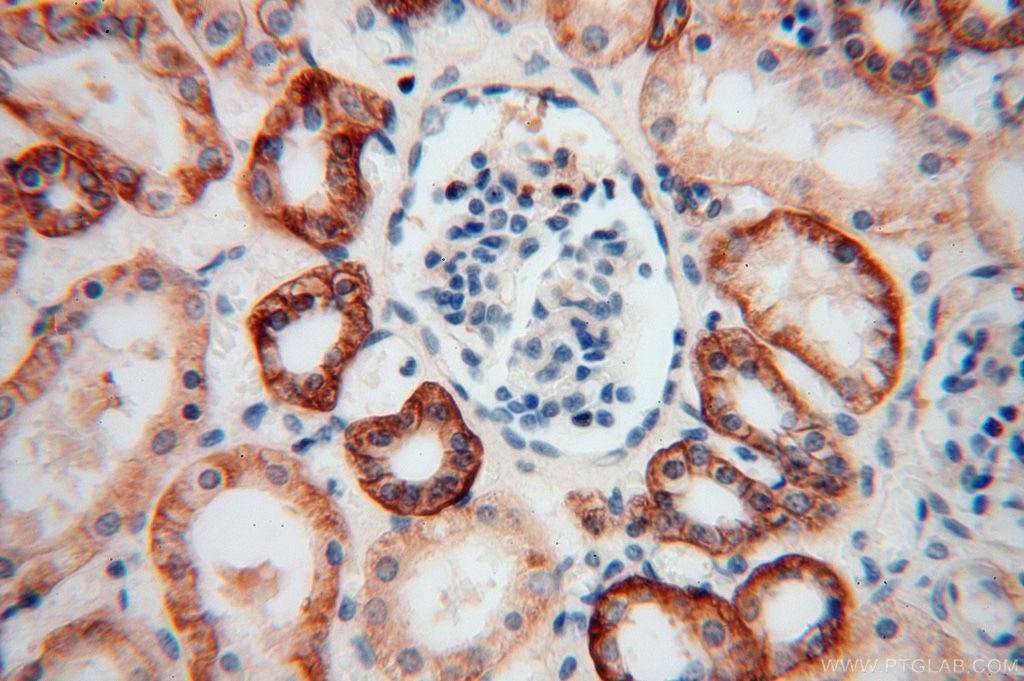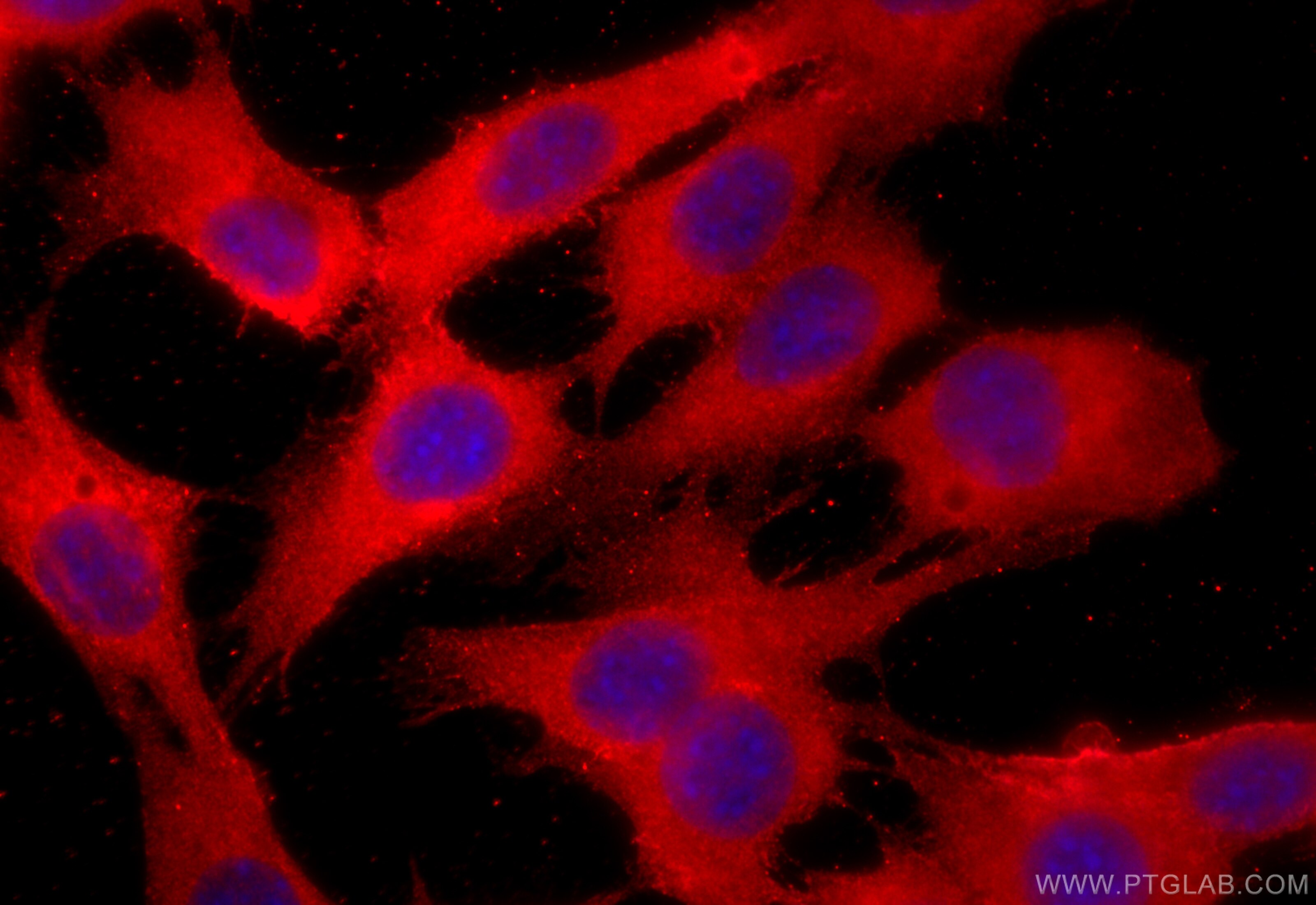Validation Data Gallery
Tested Applications
| Positive WB detected in | 37°C incubated mouse heart tissue, 37°C incubated mouse skeletal muscle tissue |
| Positive IHC detected in | mouse heart tissue, human kidney tissue, human testis tissue, human skin tissue, human heart tissue Note: suggested antigen retrieval with TE buffer pH 9.0; (*) Alternatively, antigen retrieval may be performed with citrate buffer pH 6.0 |
| Positive IF/ICC detected in | C2C12 cells |
| Positive FC (Intra) detected in | HeLa cells |
Recommended dilution
| Application | Dilution |
|---|---|
| Western Blot (WB) | WB : 1:500-1:2000 |
| Immunohistochemistry (IHC) | IHC : 1:50-1:500 |
| Immunofluorescence (IF)/ICC | IF/ICC : 1:200-1:800 |
| Flow Cytometry (FC) (INTRA) | FC (INTRA) : 0.25 ug per 10^6 cells in a 100 µl suspension |
| It is recommended that this reagent should be titrated in each testing system to obtain optimal results. | |
| Sample-dependent, Check data in validation data gallery. | |
Published Applications
| WB | See 20 publications below |
| IHC | See 4 publications below |
| IF | See 7 publications below |
Product Information
16836-1-AP targets ATP1A1/2/3/4 in WB, IHC, IF/ICC, FC (Intra), ELISA applications and shows reactivity with human, mouse, rat samples.
| Tested Reactivity | human, mouse, rat |
| Cited Reactivity | human, mouse, rat, canine, haliotis discus hannai |
| Host / Isotype | Rabbit / IgG |
| Class | Polyclonal |
| Type | Antibody |
| Immunogen |
CatNo: Ag10515 Product name: Recombinant human ATP1A2 protein Source: e coli.-derived, PGEX-4T Tag: GST Domain: 347-700 aa of BC052271 Sequence: KRMARKNCLVKNLEAVETLGSTSTICSDKTGTLTQNRMTVAHMWFDNQIHEADTTEDQSGATFDKRSPTWTALSRIAGLCNRAVFKAGQENISVSKRDTAGDASESALLKCIELSCGSVRKMRDRNPKVAEIPFNSTNKYQLSIHEREDSPQSHVLVMKGAPERILDRCSTILVQGKEIPLDKEMQDAFQNAYMELGGLGERVLGFCQLNLPSGKFPRGFKFDTDELNFPTEKLCFVGLMSMIDPPRAAVPDAVGKCRSAGIKVIMVTGDHPITAKAIAKGVGIISEGNETVEDIAARLNIPMSQVNPREAKACVVHGSDLKDMTSEQLDEILKNHTEIVFARTSPQQKLIIVE 相同性解析による交差性が予測される生物種 |
| Full Name | ATPase, Na+/K+ transporting, alpha 2 (+) polypeptide |
| Calculated molecular weight | 1020 aa, 112 kDa |
| Observed molecular weight | 97-100 kDa |
| GenBank accession number | BC052271 |
| Gene Symbol | ATP1A2 |
| Gene ID (NCBI) | 477 |
| RRID | AB_2061149 |
| Conjugate | Unconjugated |
| Form | |
| Form | Liquid |
| Purification Method | Antigen affinity purification |
| UNIPROT ID | P50993 |
| Storage Buffer | PBS with 0.02% sodium azide and 50% glycerol{{ptg:BufferTemp}}7.3 |
| Storage Conditions | Store at -20°C. Stable for one year after shipment. Aliquoting is unnecessary for -20oC storage. |
Background Information
ATP1A2 (Na+/K+-ATPase α-2 subunit) is the catalytic component of the active enzyme Na+/K+-ATPase, which catalyzes the hydrolysis of ATP coupled with the exchange of sodium and potassium ions across the plasma membrane. The Na+/K+-ATPase is composed of a larger catalytic α-subunit (~110 kDa) and a small β-subunit (~55 kDa). The α subunit has four isoforms identified to date: α1, α2, α3 and α4.The α1 isoform is expressed ubiquitously but the α2 isoform is present largely in the skeletal muscle, heart and vascular smooth muscle. The α3 isoform is found almost exclusively in neurons and ovaries. The α4 isoform is expressed in sperm. This antibody was raised against the internal region of the human ATP1A2 and can recognizes all the isoforms of α subunit. The 65kDa band detected occasionally may be the degradation product of ATP1A2.
Protocols
| Product Specific Protocols | |
|---|---|
| FC protocol for ATP1A1/2/3/4 antibody 16836-1-AP | Download protocol |
| IF protocol for ATP1A1/2/3/4 antibody 16836-1-AP | Download protocol |
| IHC protocol for ATP1A1/2/3/4 antibody 16836-1-AP | Download protocol |
| WB protocol for ATP1A1/2/3/4 antibody 16836-1-AP | Download protocol |
| Standard Protocols | |
|---|---|
| Click here to view our Standard Protocols |
Publications
| Species | Application | Title |
|---|---|---|
Nat Commun Homophilic ATP1A1 binding induces activin A secretion to promote EMT of tumor cells and myofibroblast activation. | ||
Cell Rep Multicilia dynamically transduce Sonic Hedgehog signaling to regulate choroid plexus functions | ||
Int J Biol Macromol SUMOylation of GMFB regulates its stability and function in retinal pigment epithelial cells under hyperglycemia | ||
Eur J Nucl Med Mol Imaging Tumour blood flow for prediction of human prostate cancer aggressiveness: a study with Rubidium-82 PET, MRI and Na+/K+-ATPase-density. | ||
J Cereb Blood Flow Metab Evaluating the involvement of cerebral microvascular endothelial Na+/K+-ATPase and Na+-K+-2Cl- co-transporter in electrolyte fluxes in an in vitro blood-brain barrier model of dehydration. | ||
Glia The α2β2 isoform combination dominates the astrocytic Na(+) /K(+) -ATPase activity and is rendered nonfunctional by the α2.G301R familial hemiplegic migraine type 2-associated mutation. |










